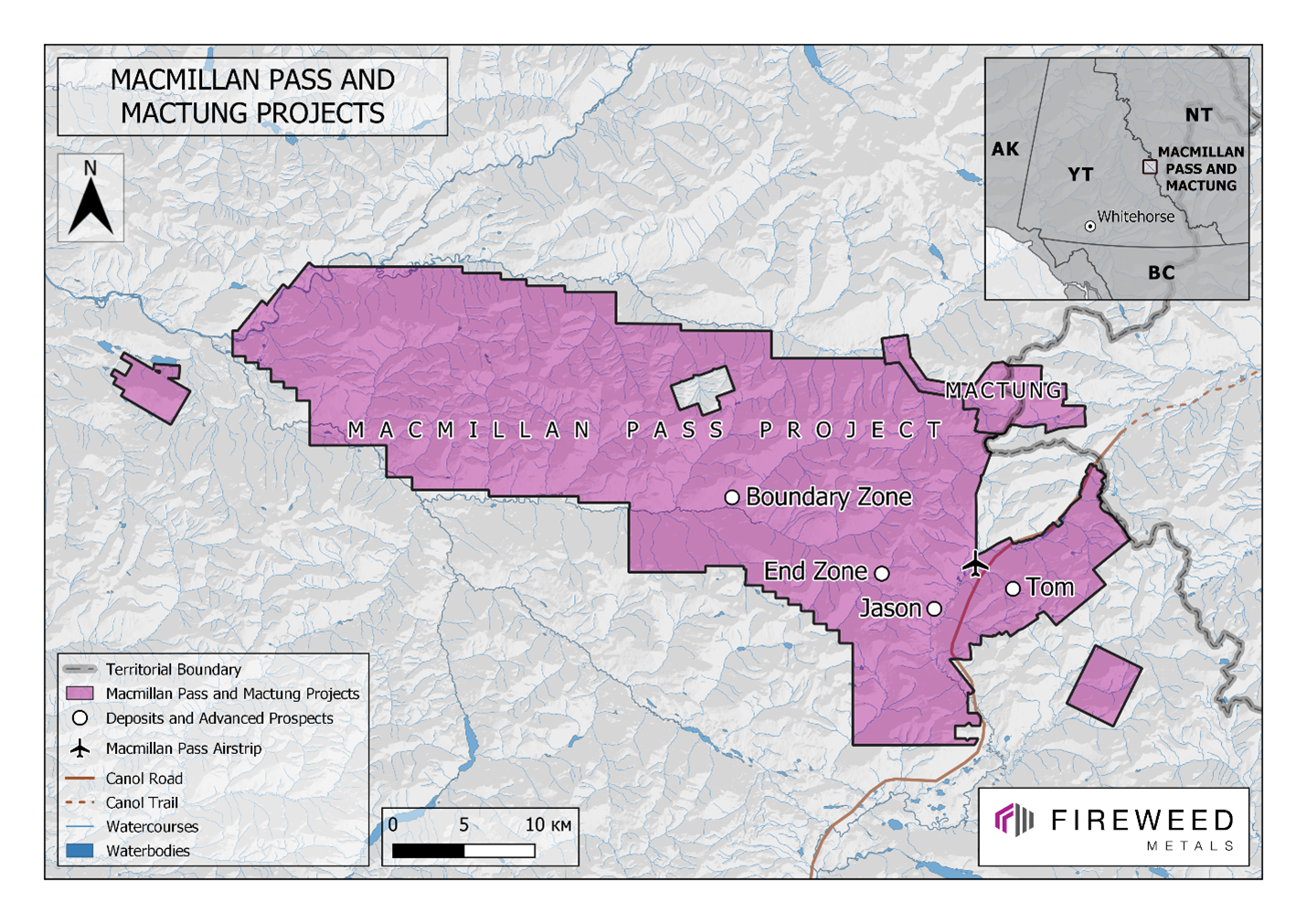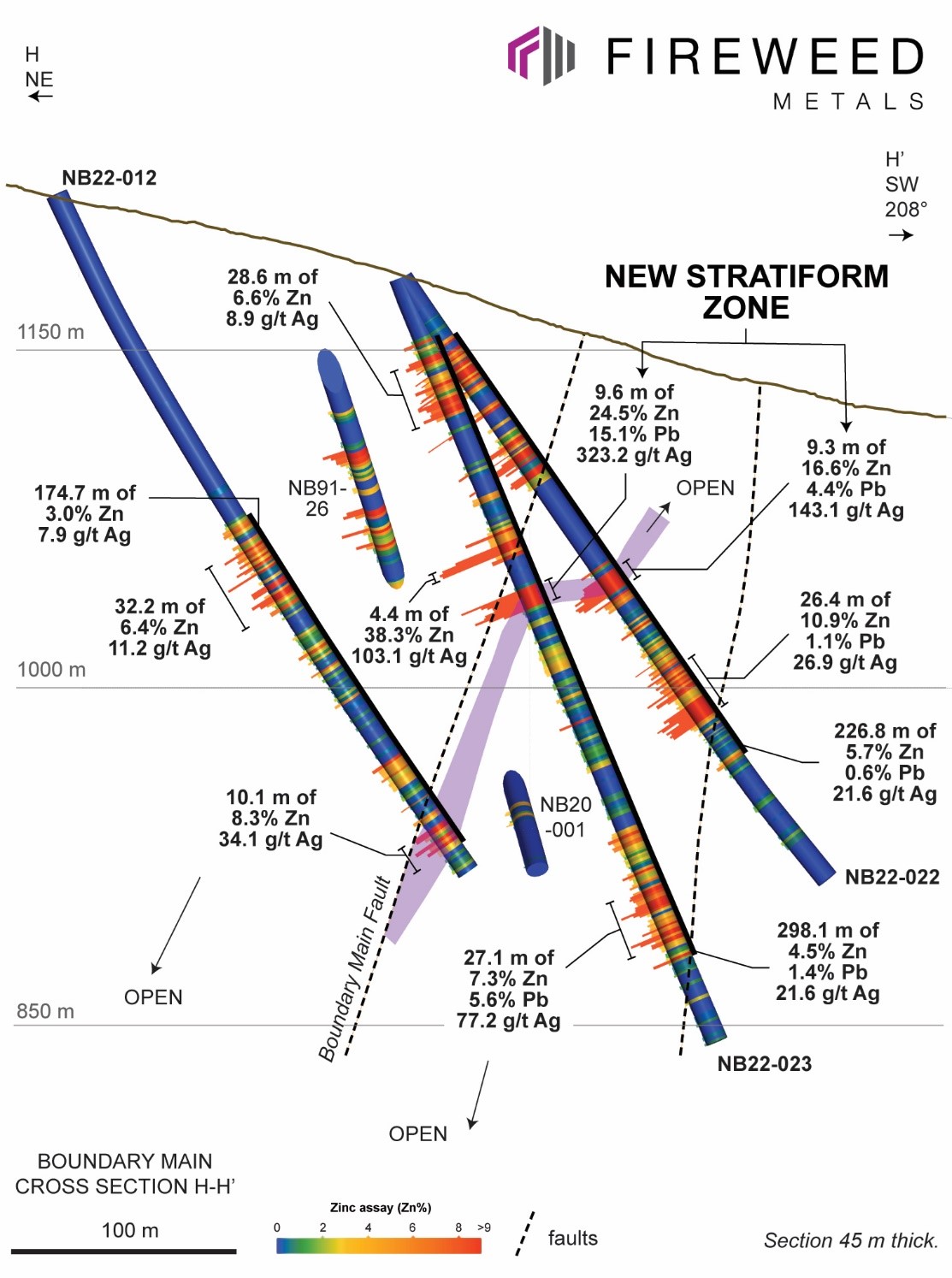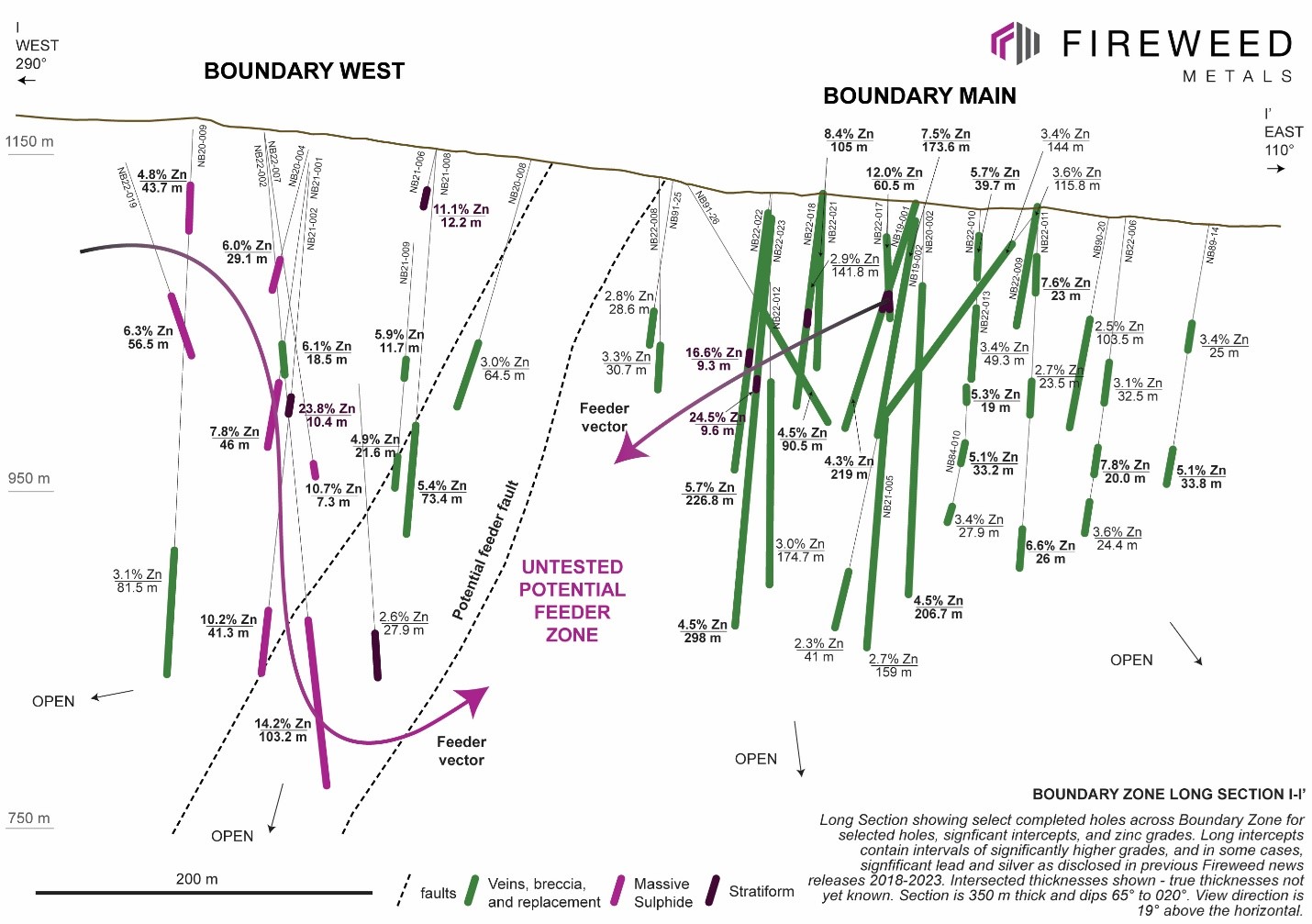Vancouver, British Columbia: FIREWEED METALS CORP. (“Fireweed” or the “Company”) (TSXV: FWZ; OTCQB: FWEDF, formerly Fireweed Zinc Ltd.) is pleased to announce the final set of results from the 2022 drill program at Boundary Zone, Macmillan Pass, Yukon, Canada (Map 1). Additional results from 9 holes drilled at the Tom deposit in 2022 are pending.
Highlights
- Multiple wide and high-grade zinc-lead-silver intersections in five different holes including many near surface intersections.
- Hole NB22-023 intersected 298 m of 4.5% zinc, 1.4% lead, and 30.9 g/t silver including a new zone of stratiform mineralization grading 24.5% zinc, 15.1% lead, and 323.2 g/t silver over 9.6 m.
- Hole NB22-022 intersected 226.8 m of 5.7% zinc, 0.6% lead, and 21.6 g/t silver including an intersection within the new stratiform zone of 9.3 m grading 16.6% zinc, 4.4% lead, and 143.1 g/t silver.
- Hole NB22-017 intersected 60.5 m of 12.0% zinc and 21.9 g/t silver starting within 20 m from surface, including 6.2 m of 40.1% zinc, and 84.2 g/t silver.
- Hole NB22-012 intersected 174.7 m of 3.0% zinc, and 7.9 g/t silver, including 32.2 m of 6.4% zinc, and 11.2 g/t silver.
CEO Statement
Brandon Macdonald, CEO, stated “The 2022 Boundary Zone drill results are nothing short of spectacular. Earlier in the season at Boundary West we drilled the best hole in 72 years of exploration anywhere at the Macmillan Pass project. The current results are not far behind and include extremely high-grade intersections within a new stratiform zone that we have now intersected in just a few holes at Boundary Main. With our biggest ever drill program planned for 2023, we see great potential for Boundary Zone.”
Boundary Zone Drilling Results
The following are the final drill results from Boundary Zone (Maps 1 and 2), all within the Boundary Main area. The last results from 9 holes from the Tom zinc-lead-silver deposit 2022 drill program are still pending.
Table 1: Boundary Zone 2022 drill result highlights from drill holes in this news release. See Table 2 for full table of results.

*Intersected thicknesses, not true thicknesses, are stated for all intersections in Table 1. Due to the early-stage of drilling, true thicknesses cannot be accurately stated for these holes. Numbers in the text may differ slightly from the table due to rounding.
NB22-012, NB22-022 and NB22-023
These holes intersected wide zones of high-grade zinc mineralization on both sides of the Boundary Main Fault (see Cross Section H-H’ and Map 2), including many near surface intersections. Above the fault are zones of vein-hosted sphalerite, including very-high grade breccias. Below the fault, NB22-022 and NB22-023 intersected the new stratiform zone, previously reported in NB22-018 and NB22-020 (see Fireweed news release dated February 27th 2023). In NB22-022 and NB22-023 the new zone is very high grade, including significant lead and silver mineralization in addition to the high-grade zinc.
Hole NB22-023 intersected 298 m of 4.5% zinc, 1.4% lead, and 30.9 g/t silver including a 36.9 m intersection of 15.1% zinc, 5.2% lead, and 127.6 g/t silver that included very high grade breccia and veins over 4.4 m grading 38.3% zinc and 103.1 g/t silver and a very high grade new stratiform zone of massive sulphide over 9.6 m grading 24.5% zinc, 15.1% lead, and 323.2 g/t silver (Tables 1 and 2). Included near the end of the 298 m interval is a 27.1 m intersection of 7.3% zinc, 5.6% lead, and 77.2 g/t silver of massive sulphide and vein mineralization hosted in volcaniclastic rocks.
NB22-022 intersected 227 m of 5.7% zinc, 0.6% lead, and 21.6 g/t silver including some high grade intervals of sphalerite vein and breccia mineralization above the Boundary Main Fault: 15.8 m of 14.5% zinc, and 27.1 g/t silver; 1.4 m of 32.8% zinc, and 29.7 g/t silver; 10.1 m of 17.0% zinc, and 40.3 g/t silver; and 3.5 m of 10.6% zinc, and 17.2 g/t silver (Tables 1 and 2). In the new zone of stratiform massive sulphide mineralization, a 9.3 m intersection graded 16.6% zinc, 4.4% lead, and 143.1 g/t silver (see Image 1). Near the base of the 227 m intersection was a sub-interval of 26.4 m that graded 10.9% zinc, 1.1% lead, and 26.9 g/t silver within silicified diamictites.
NB22-012 intersected a wide interval of sphalerite vein mineralization largely in the hangingwall of the Boundary Main Fault of 174.7 m of 3.0% zinc, and 7.9 g/t silver, including: 32 m of 6.4% zinc, and 11.2 g/t silver; 6.9 m of 5.2% zinc, and 5.1 g/t silver; and 10.1 m of 8.3% zinc, and 34.1 g/t silver.
NB22-017 and NB22-015
These two infill holes were drilled from the same pad to test high grade vein and breccia mineralization in the hangingwall of the Boundary Main Fault. Hole NB22-017 intersected 60.5 m of 12.0% zinc, 0.4% lead, and 21.9 g/t silver including a 20.4 m intersection of 25.8% zinc, 1.0% lead, and 46.4 g/t silver that contained an interval of 6.2 m of 40.1% zinc, 0.3% lead, and 84.2 g/t silver, demonstrating that this high-grade zinc mineralization is present in the near surface (see Image 2 and Tables 1 and 2). Hole NB22-015 intersected 14 m of 6.8% zinc, and 10.0 g/t silver including 2.4 m of 19.7% zinc, and 29.3 g/t silver within 30 m of surface.
Geological interpretation
Dr. Jack Milton, Chief Geologist, Fireweed Metals, remarked “Boundary West and Boundary Main are separated by a 300 m gap in the drilling at depth. To vector in on high grade feeder zones, we map out in 3D, increases in: lead mineralization; silicification of the host rocks; abundance of diamictite rocks; and geochemically anomalous indicators such as copper concentration. At Boundary we see all of these factors increase towards the gap in the drilling from both sides and this occurs across an early-formed syn-sedimentary fault that likely served as a conduit for mineralizing fluids – a potential feeder zone. On one side of this gap at Boundary West we have our best ever hole and on the other side we have these very high-grade results from the newly discovered stratiform zone that is in the same position in the stratigraphy as our Tom and Jason deposits. We see great potential for even higher grades and more metal in the feeder zone, and we are very excited to test this gap by drilling as part of our large 2023 exploration program.”.
See Long Section I-I’ for a summary of the Boundary Zone mineralization and an interpretation of the target of a potential feeder zone.
Qualified Person Statement
Technical information in this news release has been approved by Fireweed Metals Chief Geologist, Jack Milton, Ph.D., P.Geo. (BC), a ‘Qualified Person’ as defined under Canadian National Instrument 43-101.
About Fireweed Metals Corp. (TSXV: FWZ; OTCQB: FWEDF; FSE:20F): Fireweed Metals is a public mineral exploration company on the leading edge of Critical Minerals project development. Fireweed is well-funded, with a current cash position of approximately C$38,000,000 and is well-positioned to carry out a large 2023 exploration program. The Company has three projects located in Canada:
- Macmillan Pass Zinc-Lead-Silver Project: Fireweed owns 100% of the district-scale 940 km2 Macmillan Pass project in Yukon, Canada, which is host to one of the largest undeveloped zinc resources in the world* where the Tom and Jason zinc-lead-silver deposits have current Mineral Resources and a PEA economic study (see Fireweed news releases dated 10th January 2018, and 23rd May 2018, respectively, and reports filed on sedar.com for details). In addition, Boundary Zone (comprising Boundary Main, and Boundary West), Tom North (located adjacent to the Tom deposit) and End Zone have significant zinc-lead-silver mineralization drilled but not yet classified as mineral resources. The project also includes large blocks of adjacent claims with known showings and significant upside exploration potential. The large 2022 drill program utilizing four drills is complete and assay results are being announced as they are received and interpreted.
- Mactung Tungsten Project: The Company has signed a definitive Asset Purchase Agreement and acquired 100% interest in the 37.6 km2 Mactung Tungsten Project located adjacent to the Macmillan Pass Project. Mactung contains historic resources that make it one of the largest and highest-grade undeveloped resources in the world of the Critical Mineral tungsten*. Located in Canada, it is one of the rare large tungsten resources outside of China. An updated mineral resource is planned for Q2 2023, and re-sampling of historic drill core is continuing and will include assays for previously unreported by-product metals, such as gold, copper, and bismuth, in addition to tungsten.
- Gayna River Zinc-Lead-Gallium-Germanium Project: Fireweed has 100% of the 128.75 km2 Gayna River project located 180 kilometres north of the Macmillan Pass project. It is host to extensive mineralization including Critical Minerals zinc, gallium and germanium as well as lead and silver, outlined by 28,000 metres of historic drilling and significant upside potential. The results from the 2022 field program of geochemical sampling, airborne LiDAR topographic surveying and ground geophysics are now being interpreted towards defining drill targets.
In Canada, Fireweed (TSXV: FWZ) trades on the TSX Venture Exchange. In the USA, Fireweed (OTCQB: FWEDF) trades on the OTCQB Venture Market for early stage and developing U.S. and international companies and is DTC eligible for enhanced electronic clearing and settlement. Investors can find Real-Time quotes and market information for the Company on www.otcmarkets.com. In Europe, Fireweed (FSE: 20F) trades on the Frankfurt Stock Exchange.
Additional information about Fireweed and its projects can be found on the Company’s website at FireweedMetals.com and at www.sedar.com.
ON BEHALF OF FIREWEED METALS CORP.
“Brandon Macdonald”
CEO & Director
Neither the TSX Venture Exchange nor its Regulation Services Provider (as that term is defined in the policies of the TSX Venture Exchange) accepts responsibility for the adequacy or accuracy of this release.
Data verification
The diamond drill core logging and sampling program was carried out under a rigorous quality assurance / quality control program using industry best practices. Drill intersections in this release are HQ3 (split tube) size core (61.1 mm / 2.406 inch diameter) or NQ2 size core (50.5 mm/ 1.99-inch diameter) with recoveries typically above 85% unless otherwise noted in the table of results. After drilling, core was cleaned, scanned with a core scanning machine, logged for geology, structure, and geotechnical characteristics, then marked for sampling and photographed on site. The cores for analyses were marked for sampling based on geological intervals with individual samples 2 m or less in length. Drill core was cut lengthwise in half with a core saw; half-core was sent for assays reported in this news release, and the other half is stored on site for reference. Bulk density was determined on site for the entire length of each sample assayed by measurement of mass in air and mass in water. Sample duplicate bulk density determinations and in-house bulk density standard determinations were each made at a rate of 5%. Since 2017, four in-house bulk density standards (mineralized drill core from the Tom deposit that span a range of densities) have been used and show an acceptable long-term precision. Certified standard masses are used to calibrate the scale balance used for bulk density determinations.
A total of 5% assay standards or blanks and 5% core duplicates are included in the sample stream as a quality control measure and are reviewed after analyses are received. Standards and blanks in 2022 drill results to date have been approved as acceptable. Duplicate data add to the long-term estimates of precision for assay data on the project and precision for drill results reported is deemed to be within acceptable levels. Samples were sent to the Bureau Veritas preparation laboratory in Whitehorse, Yukon, where the samples were crushed and a 500 g split was sent to the Bureau Veritas laboratory in Vancouver, B.C to be pulverized to 85% passing 200 mesh size pulps. Clean crush material was passed through the crusher and clean silica was pulverized between each sample. The pulps were analyzed by 1:1:1 Aqua Regia digestion followed by Inductively Coupled Plasma Mass Spectrometry (ICP-ES/ICP-MS) multi-element analyses (BV Code AQ270). All samples were also analyzed for multiple elements by lithium borate fusion and X-ray fluorescence analysis (XRF) finish (BV Code LF725). Over-limit Pb (>25.0%) and Zn (>24.0%) were analyzed by lithium borate fusion with XRF finish (BV Code LF726). Silver is reported in this news release by method AQ270, and zinc and lead are reported by LF725 or LF726. Bureau Veritas (Vancouver) is an independent, international ISO/IEC 17025:2005 accredited laboratory.
Results in this news release are length and bulk-density weighted averages as would be used in a Mineral Resource estimate. Readers are cautioned that in Fireweed news releases prior to 2020, only length weighted assay averages were reported which may result in slightly lower (under-reported) average values. Length and bulk-density weighted averages have been reported as these most accurately represent the average metal-content of the intersections.
Cautionary Statements
Forward Looking Statements
This news release contains “forward-looking” statements and information (“forward-looking statements”). All statements, other than statements of historical facts, included herein, including, without limitation, statements relating to interpretation of drill results, future work plans, the use of funds, and the potential of the Company’s projects, are forward looking statements. Forward-looking statements are frequently, but not always, identified by words such as “expects”, “anticipates”, “believes”, “intends”, “estimates”, “potential”, “possible”, and similar expressions, or statements that events, conditions, or results “will”, “may”, “could”, or “should” occur or be achieved. Forward-looking statements are based on the beliefs of Company management, as well as assumptions made by and information currently available to Company management and reflect the beliefs, opinions, and projections on the date the statements are made. Forward-looking statements involve various risks and uncertainties and accordingly, readers are advised not to place undue reliance on forward-looking statements. There can be no assurance that such statements will prove to be accurate, and actual results and future events could differ materially from those anticipated in such statements. Important factors that could cause actual results to differ materially from the Company’s expectations include but are not limited to, exploration and development risks, unanticipated reclamation expenses, expenditure and financing requirements, general economic conditions, changes in financial markets, the ability to properly and efficiently staff the Company’s operations, the sufficiency of working capital and funding for continued operations, title matters, First Nations relations, operating hazards, political and economic factors, competitive factors, metal prices, relationships with vendors and strategic partners, governmental regulations and oversight, permitting, seasonality and weather, technological change, industry practices, uncertainties involved in the interpretation of drilling results and laboratory tests, and one-time events. The Company assumes no obligation to update forward‐looking statements or beliefs, opinions, projections or other factors, except as required by law.
Footnote
* References to relative size and grade of the Mactung historic resources and Macmillan Pass resources in comparison to other tungsten and zinc deposits elsewhere in the world, respectively, are based on review of the Standard & Poor’s Global Market Intelligence Capital IQ database.
Contact:
Brandon Macdonald
Phone: (604) 646-8361
Email: info@fireweedmetals.com

Map 1: Macmillan Pass Project and Mactung Project locations.

Map 2: Boundary Zone drilling map with holes with results in this release labeled. For green section lines, see Cross Section H-H’ and Long Section I-I’.

Image 1: Core 158.2 m to 171.8 m from drill hole NB22-022 within the new stratiform zone of massive sphalerite-pyrite-galena. Contains interval 159.21-168.5 m (9.25 m) that graded 16.6% zinc, 4.4% lead, and 143.1 g/t silver (Tables 1 and 2). Image is a high resolution photomosaic from core scanning with core boxes and blocks filtered out.

Image 2: Core 53.1 m to 68.0 m from drill hole NB22-017 within a high-grade zone of sphalerite (red-brown mineral) veins and hydrothermal breccia. Contains interval 55.0-61.2 m (6.2 m) that graded 40.1% zinc, 0.3% lead, and 84.2 g/t silver (Tables 1 and 2). Image is a high resolution photomosaic from core scanning with core boxes and blocks filtered out.

Cross Section H-H’: Highlights of new results from NB22-012, NB22-022, and NB22-023. See Table 2 for full table of results. Intersections from the new stratiform zone were first reported in Fireweed News Release dated 27th February 2023 from holes NB22-018 and NB22-020.

Long Section I-I’: A selection of significant zinc intercepts are shown on this long section to illustrate the scale of the Boundary Zone target. The vectors towards the feeder are shown towards a ~300 m gap in the drilling between Boundary West and Boundary Main, where there is a target for a potential feeder zone. The feeder vectors have been interpreted based on an increase in: zinc, lead and silver grades; copper anomalism; silicification in the surrounding mudstones; and the abundance of diamictites developed around a potential feeder fault. The potential feeder fault has significant differences in the stratigraphy on either side of the fault, demonstrating the offset on the fault to be at least in part syn-sedimentary, and therefore available for fluids as a conduit in the early history of the basin. See Map 2 for section line.
Table 2: Boundary Zone Main 2022 full table of drill results for all holes in this news release.

*Intersected thicknesses, not true thicknesses, are stated for all intersections in Table 1. Due to the early-stage of drilling, true thicknesses cannot be accurately stated for these holes. Numbers in the text may differ slightly from the table due to rounding.
Table 3: Summary of drill results from 2022 program.

All assays pending unless otherwise indicated. BM: Boundary Main; BW: Boundary West; TW: Tom West; TE: Tom East.
Table 4: 2022 Drill Collar Details.

Coordinate reference system: UTM Zone 9 NAD83. North reference: UTM grid north.

